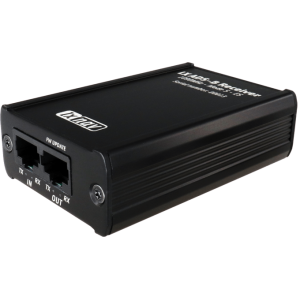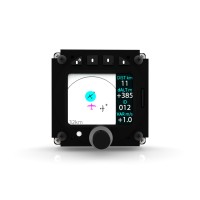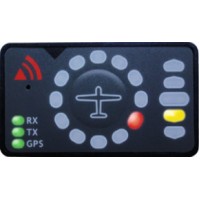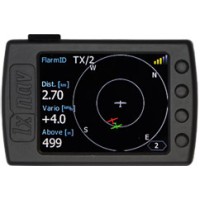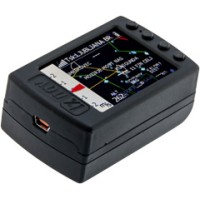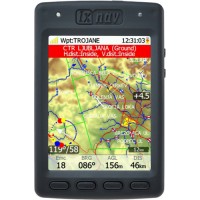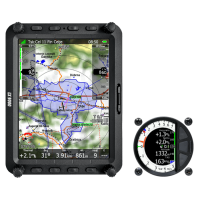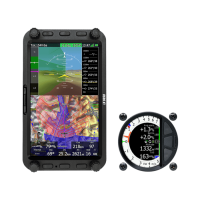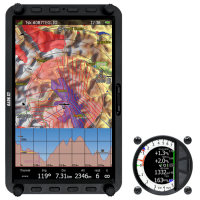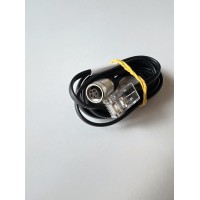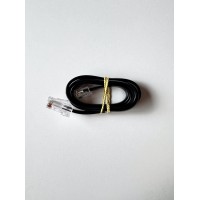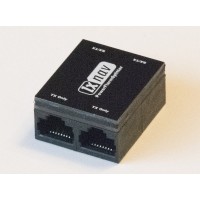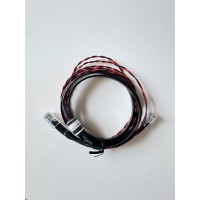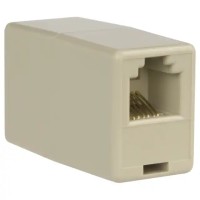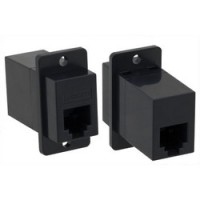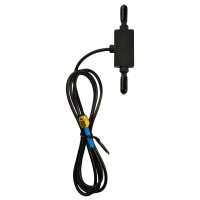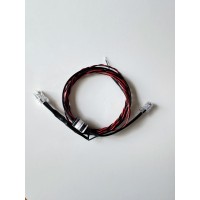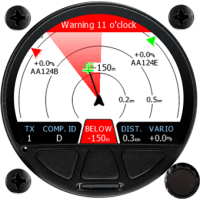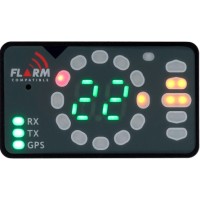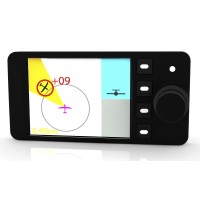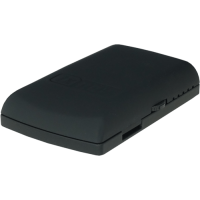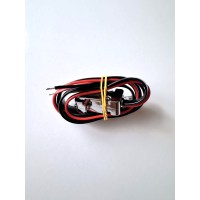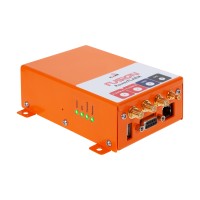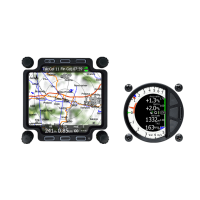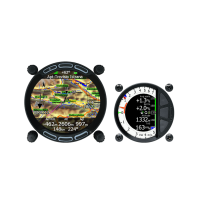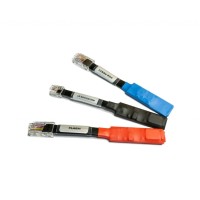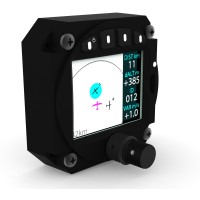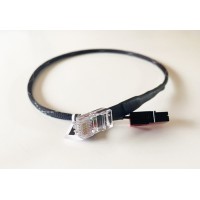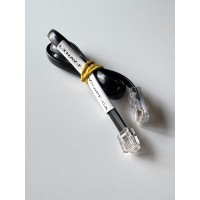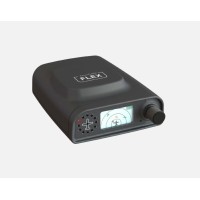LXNAV ADS-B Receiver
A practical standalone ADS-B 1090 IN solution. ADS-B receiver listens to ADS-B 1090 transmitters. Data can be displayed to any standard remote traffic display via the output port in FLARM standard NMEA format.
There are many low-cost ADS-B 1090 and UAT receivers on the market. However, they don't send traffic information in the soaring standard FLARM format, so they don't work with soaring instruments. This device does send traffic information in the standard FLARM format, so it works great for sending ADS-B 1090 traffic to any standard FLARM remote display or soaring instrument - like an LXNAV S8, S80, S10, S100, LX80x0, or LX90x0.
Does not receive or transmit FLARM traffic data. It is not recommended for sailplanes that fly in areas with other sailplanes. Most sailplanes that fly in soaring contests use PowerFLARM units.
The ADS-B Receiver not include a GPS engine or GPS antenna. GPS data is required.
An LXNAV GPSMouse could be used to send GPS data to the ADS-B Receiver's input port. However, the GPSMouse has a 6-pin RJ12 connector and the ADS-B Receiver's input port is an 8-pin RJ45 port. The GPSMouse uses "IGC Standard" wiring, so a simple adapter cable could be used, or an 8-pin connector could be put onto the GPSMouse's cable. A standard FLARM display cable like the LXNAV-FlarmViewPF-CA could be used along with a 6-pin RJ12 coupler. Since the GPSMouse needs 12V power, and the ADS-B Receiver needs 12V power, an LXNAV-Splitter-PF-RJ45 would be needed to be allow the connection of a 12V RJ45 power cable (included).
A "Classic" FLARM without ADS-B could be used to send GPS data to the ADS-B Receiver. The ADS-B Receiver would forward FLARM traffic to the connected traffic display.
Normal Operation
The ADS-B receiver goes into normal operating mode when it receives signals from enough GPS
satellites.
How the system works
The ADS-B receiver can listen for 1090 MHz transponder data (Mode S and ES). Received data will
be transmitted to the output port in FLARM standard NMEA format. The ADS-B receiver will operate only if it receives GPS data in its input port. GPS data must be
standard NMEA format. The ADS-B receiver will automatically detect the baudrate on input port and
transmit NMEA data on output port at the same baudrate.
Features
- Receives ADS-B 1090 traffic and forwards it to a connected traffic display
- May also receive relayed ADS-R (ADS-B UAT) traffic if you have ADS-B OUT and are near a radar ground station. This feature should work, but the manufacturer is in Europe and ADS-B UAT isn't used in Europe - so it isn't fully tested.
- Works with all standard FLARM displays (3V and 12V)
Input and Output
- 2 x RJ45 FLARM power/data ports (IGC Standard connections)
- Input voltage 8-36 VDC
- Consumption 0.85 W
Power
- Power input 8 to 36 VDC
- Consumption 0.85 W
Size and Weight
- Outline dimension (not including connectors): 90 x 55 x 25 mm (3.54 x 2.17 x 1.0 inches)
- Weight of ADS-B Receiver unit: 160 g (5.6 ounces)
Included
- ADS-B Receiver unit
- ADS-B Dipole Antenna with cable with SMA connector
- 12V power cable with RJ45 8-pin connector
- FLARM display cable, LXNAV-FlarmViewPF-CA
Optional Remote Traffic Displays:
- LXNAV FlarmLED
- LXNAV FlarmLED+
- LXNAV FlarmView
- LXNAV TrafficView
- LXNAV Nano3
- LXNAV Nano4
- Air Avionics ATD-11 Air Traffic Display
- Air Avionics ATD-57 Air Traffic Display
Manual
Details are available in the ADSB Receiver manual which is available here.
Related Products
AIR-ATD-57
AIR Traffic Display, ATD-57Enhance Your Traffic AwarenessAIR Traffic Display is our newly designed p..
$555.00
LXNAV-FlarmLED
LXNAV FlarmLEDThe new FlarmView is a very small and simple display for use with FLARM and PowerFLARM..
$130.00
LXNAV-FlarmView
LXNAV FlarmViewThe FlarmView is a very small and full-featured display for use with FLARM and PowerF..
$220.00
LXNAV-Nano3
LXNAV Nano 3 GPS Flight Recorder with variometer and color navigation displayLXNAV Nano3 Overview&nb..
$650.00
LXNAV-Nano4
LXNAV Nano 4 GPS Flight Recorder with variometer and color touchscreen navigation displayThe Nano 4 ..
$760.00
LXNAV-LX9000
LX9000 with V8 VariometerThe LX 9000 is a high end vario navigation system with extremely brigh..
$4,830.00
LXNAV-LX9050
LX9050 with V8 Variometer The LX9050 is a high end vario navigation system with extremely ..
$4,170.00
LXNAV-LX9070
LX9070 with V8 Variometer The LX9070 is a high end vario navigation system with extremely ..
$5,270.00
LXNAV-LX5-PF
Cable for connecting LX 7000, LX 7007, LX 80X0 or LX 90X0 to PowerFLARMThis cable connects a Po..
$45.00
LXNAV-S7-GPS-PF
Cable for connecting S7, S8, S80, S10 or S100 GPS Port to PowerFLARM or K6 MuxThis cable connects th..
$35.00
LXNAV-Splitter-PF-RJ45
LXNAV Splitter with 4 RJ45 8-pin Ports and cable with RJ45 8-pin connectorFor connecting up to 3 dev..
$40.00
Goddard-Cable-PF-RJ45-Pwr-2
Cable, 2 m (6.56 feet), PowerFLARM RJ45 port to 12V PowerThe cable has an RJ45 connector for connect..
$40.00
Goddard-Cable-PF-RJ45-Pwr-FDispl-1
Cable, 1 m (3.28 feet), PowerFLARM RJ45 port to 12V Power and RJ12 for FLARM displayThe cable has an..
$75.00
RJ-Coupler-RJ12-RJ12
RJ12 CouplerFemale RJ12 receptacles with 6 conductors on both ends. The connections are "strai..
$7.00
RJ-Coupler-RJ12-RJ12-Panel
RJ12 Coupler, Panel MountThe same the RJ adapter used in the CAA-127 mounting plate. It does&n..
$9.00
FLARM-Ant-ADSB-Dipole-SMA
PowerFLARM Dipole ADS-B Antenna with Standard Polarity ConnectorConnects directly to a PowerFLARM Fu..
$40.00
Goddard-Cable-PF-RJ45-Pwr-S7-0.5
Cable, 0.5 m (19.7 inches), PowerFLARM RJ45 port to 12V Power and RJ12 for LXNAV S7, S8 or S80, or L..
$75.00
LXNAV-TrafficView
LXNAV TrafficView57 & TrafficView80The TrafficView is designed to have the largest traffic displ..
$495.00
LXNAV-FlarmLED+
LXNAV FlarmLED+The new FlarmView+ is a very small and simple display for use with FLARM and PowerFLA..
$190.00
AIR-ATD-11
AIR Traffic Display, ATD-11The ADT-11 has a larger display than most FLARM traffic displays - making..
$555.00
LXNAV-GPSMouse
GPSMouse66 channel GPS engine with built-in GPS antenna, For use with LXNAV S7, S8, and S80, Also wo..
$170.00
LXNAV-PowerMouse-CA-Update-Pwr
PowerMouse update cable with RJ45 8-pin connector for PowerMouse or PowerFLARM and DB-9f connector f..
$40.00
FLARM-PowerFLARM-Fusion
FLARM Home | Safety Considerations | FLARM Logger IGC Approval | Power..
$2,050.00
LXNAV-LX8040
LX8040 with V8 Variometer The LX8040 is a high end vario navigation system with extremely brigh..
$2,960.00
LXNAV-LX8030
LX8030 with V8 Variometer The LX8030 is a high end vario navigation system with extremely brigh..
$2,520.00
Naviter-Bluetooth-Dongle
Naviter Bluetooth DongleDescriptionThe Naviter Bluetooth Dongle converts any flight instrument with ..
$99.00
AIR-ATD-80
AIR Traffic Display, ATD-80*** Fits in large, 80 mm (3 1/8") instrument holeEnhance Your Traffic Awa..
$650.00
Goddard-Cable-PF-RJ45-Pwr-APP-0.5
Cable-PF-RJ45-Pwr-APP-0.5, Cable, 0.5 m, For connecting 12V power to a PowerFLARM's RJ45 connector, ..
$50.00
LXNAV-FlarmViewPF-CA
Cable for connecting PowerFLARM RJ45 port to FLARM displayFlarm display cable, 70 cm (27.5"), 8-pin ..
$35.00
FLARM-PowerFLARM-Flex
PowerFLARM FlexBrochure: PowerFLARM Flex Datasheet - EnglishIntroducing PowerFLARM Flex—the new..
$1,595.00

